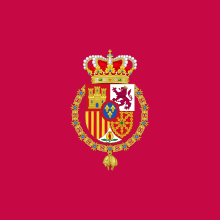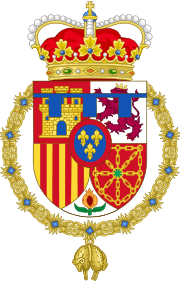Felipe VI of Spain
| Felipe VI | |||||
|---|---|---|---|---|---|
|
| |||||
| King of Spain (more) | |||||
| Reign | 19 June 2014 – present | ||||
| Enthronement | 19 June 2014 | ||||
| Predecessor | Juan Carlos I | ||||
| Heir presumptive | Leonor | ||||
| Prime Minister | Mariano Rajoy | ||||
| Born |
30 January 1968 Nuestra Señora de Loreto Clinic, Madrid, Spain | ||||
| Spouse | Letizia Ortiz Rocasolano (m. 2004) | ||||
| Issue |
Leonor, Princess of Asturias Infanta Sofía | ||||
| |||||
| House | Bourbon[1][lower-alpha 1] | ||||
| Father | Juan Carlos I of Spain | ||||
| Mother | Sofía of Greece and Denmark | ||||
| Religion | Roman Catholic | ||||
| Signature |
 | ||||
| Spanish Royal Family |
|---|
.svg.png) |
|
|
Felipe VI (Spanish: [feˈlipe];[lower-alpha 2] born 30 January 1968) is the King of Spain. He ascended to the throne on 19 June 2014 following the abdication of his father, King Juan Carlos I.[3][4][5] He was created Prince of Asturias in 1977 and as heir apparent to the throne, he worked to support philanthropic causes and to promote international fellowship among Spanish-speaking countries.
In accordance with the Spanish Constitution, as monarch, he is head of state and commander-in-chief of the Spanish Armed Forces,[6][7] and also plays a role in promoting relations with Hispanic America, the "nations of its historical community".[6][7] He is married to Letizia Ortiz Rocasolano, with whom he has two daughters, Leonor and Sofía. Leonor, the elder, is his heir presumptive.
He is the world's fourth-youngest reigning monarch, after King Jigme Khesar Namgyel Wangchuck of Bhutan, Sheikh Tamim bin Hamad Al Thani of Qatar,[8][9] and King Mswati III of Swaziland.
Birth and early life
Felipe was born in Madrid at the Nuestra Señora de Loreto Clinic, the third child and only son of Infante Juan Carlos of Spain and Princess Sofía of Greece and Denmark.[10][11] He was baptised on 8 February 1968 at the Palace of Zarzuela by the Archbishop of Madrid, Casimiro Morcillo.[12] His full baptismal name, Felipe Juan Pablo Alfonso de Todos los Santos, consists of the names of the first Bourbon King of Spain (Philip V), his grandfathers (Infante Juan of Spain and King Paul of Greece), his great-grandfather King Alfonso XIII of Spain, and de Todos los Santos as is customary among the Bourbons.[13] His godparents were his paternal grandfather Juan and his paternal great-grandmother, Queen Victoria Eugenie of Spain.[12][13][14] Shortly after his birth he was styled infante, although his father was not yet king. The ruling dictator General Francisco Franco died just over two months before Felipe's eighth birthday, and Felipe's father ascended the throne. In his first official appearance, Felipe attended his father's proclamation as king on 22 November 1975.[11]
In 1977, Felipe was formally created Prince of Asturias.[14][15][16] In May, nine-year-old Felipe was made an honorary soldier of the 1st King's Immemorial Infantry Regiment.[17] The occasion was marked on 28 May and was attended by the king, the prime minister and several other ministers in a ceremony at the infantry's barracks.[18][19] On 1 November the same year, he was ceremoniously paid homage as Prince of Asturias in Covadonga.[13][20] In 1981 Felipe received the Collar of the Order of the Golden Fleece from his father, the Chief and Sovereign of the Order.[13][21] On his 18th birthday on 30 January 1986, Felipe swore allegiance to the Constitution and to the King in the Spanish Parliament as required by the constitution, fully accepting his role as successor to the Crown.[11][22]
Education and military training
Felipe attended school at Santa María de los Rosales,[11] which his daughters currently attend. Felipe attended high school at Lakefield College School in Ontario, Canada, and studied at the Autonomous University of Madrid, where he graduated with a degree in Law; he also completed several courses in Economics.[13] He completed his academic studies by obtaining a Master of Science in Foreign Service degree from the Edmund A. Walsh School of Foreign Service at Georgetown University, where he was the roommate of his cousin, Crown Prince Pavlos of Greece.[23]
As the heir to the throne, a carefully regulated and structured plan was laid out for Felipe's military training. In August 1985, a Royal Decree named Felipe as officer at the General Military Academy in Zaragoza.[24][25] He began his military training there in September.[26] He completed the first phase of his formation in October.[27] In July 1986, he was promoted to Cadet 2nd Lieutenant. He was also named as Midshipman.[28] On September 1986, he began his naval training at the Escuela Naval Militar in Pontevedra, joining the Third Brigade.[29] In January 1987, he continued his naval training on board the training ship Juan Sebastián Elcano.[30] In July, he was named as Student Ensign at the Academia General del Aire in Murcia.[31] In September 1987, he began his air force training there.[32] where he learned to fly aircraft.[33] In 1989, he was promoted to Lieutenant in the Army, Ensign in the Navy, and Lieutenant in the Air Force. In 1992, he was promoted to Captain in the Air Force.[34] In 1993, he was promoted to Lieutenant in the Navy and Captain in the Infantry of the Army.[35] In 1999, a law was passed regulating his military career.[36]
Further promotions in 2000 were Commandant in the Army, Corvette Captain in the Navy, and Commandant in the Air Force. Promotions in 2009 were Lieutenant Colonel in the Army, Frigate Captain in the Navy, and Lieutenant Colonel in the Air Force.
Since June 19, 2014, after his ascension to the throne, he acquired the rank of Capitán General (Commander-in-chief) of all the Spanish armies (Land, Navy and Air Force).
Activities in Spain and abroad

Felipe undertook his constitutional duties assiduously as heir to the throne, hosting many official events in Spain and participating in all events of different sectors and aspects of Spanish public life as required. Since October 1995, Felipe has represented Spain on a series of official visits to the Spanish Autonomous Communities, starting with Valencia,[11] during which he made contact with Spaniards from all walks of life. Felipe has held regular meetings with constitutional bodies and state institutions keeping up-to-date with their activities.[13] He also attends meetings of the various bodies of the Central Administration and of the Autonomous Communities as required by his national and international constitutional obligations. Felipe has welcomed as many public and private audiences as possible to maintain Crown interaction in national and international affairs. In particular, he has held meetings with people of his generation who have built successful careers in political, economic, cultural and media circles. As part of his military training, Felipe trained as a military helicopter pilot.[13] On occasions when King Juan Carlos was unable to attend, Felipe presided over the annual presentation of dispatches to officers and non-commissioned officers in the Armed Forces as well as participating in military exercises held by the three Armed Services.[13]
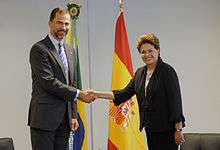
Felipe has made many official visits to Europe and Latin America, as well as to countries in the Arab World, the Far East, and Australia, maintaining a special interest in all matters relating to the European Union, Latin America, the Middle East and North Africa. Since January 1996, Felipe has represented the Spanish State at many Latin American presidents' inauguration ceremonies.[13] As Prince, he visited every country in Latin America except Cuba, and made over 200 foreign trips in total.[37] Felipe has also played a very active role in promoting Spain's economic, commercial and cultural interests and the Spanish language abroad. He frequently represents Spain at world economic and trade events (e.g. Expotecnia, Expoconsumo, and Expohabitat), and is especially interested in promoting the creation of Centres and University Chairs to advance the study of Spain both historically and in the present-day at major foreign universities.
Following the 11 March 2004 Madrid bombings, Felipe, along with his sisters Elena and Cristina, took part in a public demonstration.[11]
Felipe speaks Spanish, Catalan, French, English and some Greek.[38]
Social work
In addition to his official activities, Felipe serves as Honorary President of several associations and foundations, such as the Imperial Munitions Board, which finances economic and social development in Ibero-America and other countries,[13] and the Spanish branch of the Association of European Journalists, comprising outstanding communications professionals. Most noteworthy is the Príncipe de Asturias Foundation, where he presides annually at the international awards ceremony of the highly prestigious Prince of Asturias Awards bearing his name.[39][40]
Felipe was appointed a "UN-Eminent Person" by UN Secretary General Kofi Annan in 2001, during its International Year of Volunteers,[41] and continues to make contributions internationally towards enhancing the importance of voluntary work.
Sports and participation in the Olympics
Felipe was a member of the Spanish Olympic sailing team at the Barcelona Games in 1992. Felipe took part in the opening ceremony as the Spanish team's flag bearer. The Spanish crew finished in sixth place in the Soling class and obtained an Olympic diploma.[42]
Felipe has been a supporter of Atlético Madrid since watching them win the 1976 Copa del Generalísimo Final.[43]
Felipe, himself 197 cm (6 ft 5 1⁄2 in) in height, has attended Spanish, European, and Olympic basketball championships.[44][45][46]
Both his mother and uncle were on the Greek sailing team at the 1960 Summer Olympics in Rome (his mother as a substitute), and Felipe's father and sister were also Olympic sailors for Spain.[47]
Reign
.jpg)
On 2 June 2014, King Juan Carlos announced his intent to abdicate in Felipe's favour. Since the Constitution of Spain did not provide a specific mechanism for abdication and royal succession, the Spanish Cabinet began deliberations on an organic law to regulate Felipe's succession on 3 June. The law had to be passed by a majority of all members of the Congress of Deputies, the lower house of the Cortes Generales (Parliament). According to Jesús Posada, the President of the Congress of Deputies, Felipe could have been proclaimed king as early as 18 June.[48] On 4 June, El País of Madrid reported that Felipe would indeed be proclaimed king on 18 June.[5]
Felipe ascended the throne at the stroke of midnight on 19 June; his father had signed the formal instrument of abdication just hours earlier.[3] The next morning, after receiving the general's sash from his father, he was formally enthroned in a low-key ceremony held in the Cortes. He swore to uphold the Constitution before formally being proclaimed king by Posada.[49] Upon his accession, he became the youngest monarch in Europe, being nine months younger than King Willem-Alexander of the Netherlands.
As king, Felipe has fairly extensive reserve powers on paper. He is the guardian of the Constitution, responsible for ensuring it is obeyed. While he is nominally chief executive, it is expected that he will follow his father's practice of taking a mostly ceremonial and representative role, acting largely on the advice of the government. He indicated as much in a speech to the Cortes on the day of his enthronement, saying that he would be "a loyal head of state who is ready to listen and understand, warn and advise as well as to defend the public interest at all times".[49] A poll conducted by El País, however, indicates that a majority of Spaniards wish that Felipe play a greater role in politics, with 75% of the 600 surveyed people stating that they would approve if he personally pushed the political parties to reach agreements on national problems.[50] According to an El Mundo newspaper poll, Felipe had a greater approval than his father prior to his reign.[51]
In June 2014, Felipe and Letizia became the first Spanish monarch and consort to receive and recognize LGBT organisations at the Palace.[52] Felipe also changed the protocol in order to allow people to take the oath of office without a crucifix or Bible.[53] In their first overseas trip as monarchs, Felipe VI and Queen Letizia met Pope Francis on 30 June 2014, in the Apostolic Palace. They subsequently met with Cardinal Secretary of State Pietro Parolin, accompanied by Mgsr. Antoine Camilleri, under-secretary for Relations with States. The visit followed one by King Juan Carlos I and Queen Sofía on 28 April.[54]
In February 2015, Felipe announced that he would cut his annual salary by 20% as a result of the economic recession and hardships continuing to hamper Spain.[55]
In March 2016, leaked texted messages between Queen Letizia and businessman Javier Lopez Madrid, created a furore. Together with other executives and board members of the Caja Madrid and Bankia financial group, Madrid had been accused of corruption. In October 2014, Letizia pledged her support for him, texting "We know who you are and you know who we are. We know each other, like each other, respect each other. To hell with the rest. Kisses yoga mate (miss you!!!)". Felipe also joined in, texting "We do indeed!" Publication of the texts by the newspaper El Diario threatened to undo the line Felipe had drawn between himself and the scandal of Princess Cristina and her husband, as well as questions over the origins of ex-King Juan Carlos's private fortune. A palace official subsequently stated that the King and Queen were no longer friends with Madrid due to his legal issues.[56][57]
The elections in 2015 resulted in no party winning enough seats to form a government. No agreements with the different parties were successful. After months of talks with the different party leaders, and with there being no apparent candidate in a position of support in forming a government, a royal decree was issued dissolving parliament with new elections being called in June.[58] This marked the first time since the transition to democracy that an election was called under Article 99.5 of the Constitution, wherein the initiative for issuing the dissolution of the Cortes belonged to the King and not to the Prime Minister.[59]
Marriage and issue
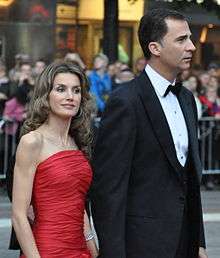
Felipe's bachelor years were a source of interest to the Spanish press for several years. His name was linked with several eligible women, but only two notable girlfriends: Spanish noblewoman Isabel Sartorius, around 1989 to 1991, daughter of Vicente Sartorius y Cabeza de Vaca, who was viewed unfavourably by the Royal Family due to her mother's cocaine addiction,[60] and Norwegian model Eva Sannum, who modelled underwear.[61] When Felipe finally began a serious relationship, nothing was suspected before the official announcement of the Prince's engagement on 1 November 2003 to Letizia Ortiz Rocasolano, an award-winning television journalist formerly with CNN who had been married previously. The couple were married on the morning of 22 May 2004 in the Almudena Cathedral, Madrid, with representatives of royal families from all over the world and most heads of state from Latin America present.[11]
Felipe and Letizia have two daughters: Leonor, Princess of Asturias, born on 31 October 2005, and Infanta Sofía, born on 29 April 2007.[11]
Titles, styles and arms
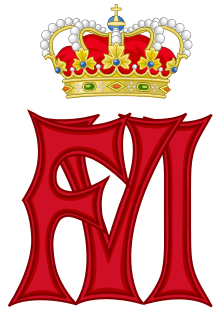
Titles and styles
- 30 January 1968 – 22 January 1977: His Royal Highness Infante Felipe of Spain
- 22 January 1977 – 19 June 2014: His Royal Highness The Prince of Asturias
- in former Crown of Aragon territories: 22 January 1977 – 19 June 2014: His Royal Highness The Prince of Girona
- in former Kingdom of Navarre territories: 22 January 1977 – 19 June 2014: His Royal Highness The Prince of Viana
- 19 June 2014 – present: His Majesty The King
Though Juan Carlos held no official title or post in Spain prior to 1969, his son Felipe was registered in the Civil Registry as an 'Infante' when he was born, with the style of Royal Highness. About a year later, General Franco recognised Juan Carlos as the future successor to the headship of state and bestowed upon him the title of Prince of Spain. Thus, Felipe became second-in-line in the line of succession to the vacant throne.
Juan Carlos became king in 1975, but no title was conferred on Felipe as heir apparent until 1977, when he was created Prince of Asturias, the traditional title normally held by the heir to the Spanish throne. The royal decree granting him this title also entitled him to use "the other historical titles corresponding to the heir of the Crown".[15] Felipe started using the Aragonese-Catalan title of Prince of Girona publicly on 21 April 1990, during a trip around Aragon, Catalonia and Valencia, becoming the first Bourbon to use this title.[62] Later, he did the same thing with the Princedom of Viana in Navarre, and the titles of Duke of Montblanc, Count of Cervera and Lord of Balaguer in their respective places.
Upon ascending the throne, Felipe assumed the same titles held by his father. If the former Kingdoms of Aragon and Navarre had separate naming styles, he would also be known as Felipe V of Aragon and Felipe VII of Navarre along with Felipe VI of Castile.[63]
Arms

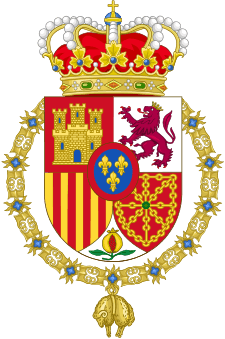
As heir to the Spanish throne, Felipe's coat of arms were the coat of arms of Spain differenced with a label of three points azure (blue).[64] The first quarter represents Castile, the second León, the third Aragon and the fourth Navarre; below are the arms of Granada. In the centre, on an inescutcheon, is the ancestral arms of the sovereign House of Bourbon-Anjou. Surrounding the shield is the collar of the Order of the Golden Fleece and surmounting it was the heraldic crown of the heir to the throne, decorated with four half-arches.
Following his accession to the throne, the label on his arms was removed and the crown of the heir was changed to that of the monarch's (eight half-arches instead of four).[65] This arms differ from that of his father's as king as they do not feature the Cross of Burgundy or the yoke, and sheaf of five arrows.
Ancestry
See also
- Line of succession to the Spanish throne
- List of honours of the Spanish Royal Family by country
- Princess of Asturias Awards
Notes
- ↑ The English-language version of the Official Royal Family website is rendered as "Borbon", while in Spanish it is rendered as "Borbón". In English, the house is traditionally called House of Bourbon.
- ↑ Most English-language media refer to the king as Felipe VI, although a few sources have rendered his name as Philip VI.[2] In the languages of Spain, his name is:
References
- ↑ "His Majesty the King Juan Carlos". The Royal Household of His Majesty the King. Archived from the original on 18 February 2011.
- ↑ e.g. New Statesman
- 1 2 "Felipe takes over as king of Spain". BBC News. 18 June 2014.
- ↑ Govan, Fiona (13 June 2014). "Spain will have two kings and two queens". The Telegraph. Retrieved 14 June 2014.
- 1 2 Garea, Fernando; Fabra, María (3 June 2014). "Coronation of Prince Felipe to take place on June 18". El Pais.
- 1 2 (Spanish) Título II. De la Corona. Es.wikisource.org. Retrieved on 21 June 2014.
- 1 2 Title II, Article 56, Subsection 1, Text:
The King is the Head of State, the symbol of its unity and permanence. He arbitrates and moderates the regular functioning of the institutions, assumes the highest representation of the Spanish State in international relations, especially with the nations of its historical community, and exercises the functions expressly conferred on him by the Constitution and the laws
El Rey es el Jefe del Estado, símbolo de su unidad y permanencia, arbitra y modera el funcionamiento regular de las instituciones, asume la más alta representación del Estado español en las relaciones internacionales, especialmente con las naciones de su comunidad histórica, y ejerce las funciones que le atribuyen expresamente la Constitución y las leyes - ↑ Vargas, Marc; Binding, Lucia (8 June 2016). "Queen Letizia of Spain reveals slimline figure alongside King Felipe VI at Madrid press event". International Business Time. Retrieved 31 July 2016.
- ↑ "PHOTOS: Meet the world's other popular royal families". Rediff. 20 April 2016. Retrieved 31 July 2016.
- ↑ "La princesa doña Sofia dio a luz ayer su primero hijo varon". ABC (in Spanish). 31 January 1968. p. 43. Retrieved 23 December 2015.
- 1 2 3 4 5 6 7 8 "Casa de Su Majestad el Rey de España – Actividades y Agenda – Hitos más importantes de Su Alteza Real el Príncipe de Asturias". Casareal.es (in Spanish). Retrieved 20 June 2014.
- 1 2 "Apadrinado por don Juan y la Reina Doña Vicotria, recibo ayer las aguas bautismales el infante don Felipe". ABC (in Spanish). 9 February 1968. p. 23. Retrieved 23 December 2015.
- 1 2 3 4 5 6 7 8 9 10 "Casa de Su Majestad el Rey de España – S.M. el Rey Don Felipe VI". Casareal.es (in Spanish). Retrieved 20 June 2014.
- 1 2 "Don Felipe de Borbón, principe de Asturias". El Pais (in Spanish). 22 January 1977. Retrieved 20 June 2014.
- 1 2 3 Boletín Oficial del Estado: no. 19, p. 1542, 22 January 1977. (Spanish)
- ↑ In addition, he was also allowed to use "other titles and designations traditionally used by the heir to the throne" (i.e. Prince of Girona and Prince of Viana).[15]
- ↑ "Incoporación del principe Felipe al ejercito como soldado honorario". ABC (in Spanish). 22 May 1977. p. 7. Retrieved 10 December 2015.
- ↑ "El Príncipe Felipe será desde hoy soldado honorario". El País (in Spanish). 28 May 1977. Retrieved 10 December 2015.
- ↑ García, Sebastian (29 May 1977). "El Príncipe de Asturias, soldado de honor del regimiento Inmemorial del Rey". El País. Retrieved 10 December 2015.
- ↑ "Homenaje a don Felipe como Príncipe de Asturias". ABC (in Spanish). 2 November 1977. p. 5. Retrieved 24 December 2015.
- ↑ Boletín Oficial del Estado: Real Decreto 865/1981
- ↑ Schumacher, Edward (31 January 1986). "Spanish Prince, 18, Sworn in as the Heir Apparent". The New York Times. Retrieved 7 January 2016.
- ↑ Eilers, Marlene (1997) Queen Victoria's Daughters. Rosvall Royal Books, Falkoping, Sweden. ISBN 91-630-5964-9
- ↑ Yárnoz, Carlos (3 August 1985). "Don Felipe de Borbón ingresará en la Academia Militar de Zaragoza el 2 de septiembre". El Pais (in Spanish). Retrieved 26 February 2016.
- ↑ Boletín Oficial del Estado
- ↑ Yárnoz, Carlos (3 September 1985). "El Príncipe de Asturias comienza su formación militar". El Pais (in Spanish). Retrieved 26 February 2016.
- ↑ Valdecantos, Camilo (11 October 1985). "Príncipe Felipe concluye la primera fase de su formación en la Academia de Zaragoza". El Pais (in Spanish). Retrieved 26 February 2016.
- ↑ Boletín Oficial del Estado
- ↑ "El Príncipe de Asturias, guardia marina en la Escuela Naval". El Pais (in Spanish). 2 September 1986. Retrieved 26 February 2016.
- ↑ Camilo, Valdecantos (8 January 1987). "El Príncipe inicia su periodo de instrucción en el buque escuela 'Elcano'". El Pais (in Spanish). Retrieved 26 February 2016.
- ↑ Boletín Oficial del Estado
- ↑ Reverte, Paloma (3 September 1987). "El Príncipe de Asturias inicia en San Javier su último curso de formación militar". El Pais (in Spanish). Retrieved 26 February 2016.
- ↑ "El Príncipe de Asturias realiza su primer vuelo en San Javier". El Pais (in Spanish). 15 September 1987. Retrieved 26 February 2016.
- ↑ "El príncipe Felipe, capitán". El Pais (in Spanish). EFE. 28 July 1992. Retrieved 26 February 2016.
- ↑ "El príncipe Felipe asciende a capitán de Infantería". El Pais (in Spanish). EFE. 3 February 1993. Retrieved 26 February 2016.
- ↑ Boletín Oficial del Estado
- ↑ "King Felipe VI gets to work by holding first meeting with PM". El Pais. 20 June 2014. Retrieved 20 June 2014.
- ↑ "Barcelona – A Viewer's Guid: The Sports; Felipe Hoists Flag for Spain." The New York Times (19 July 1992). Retrieved on 21 June 2014.
- ↑ Fundación Príncipe de Asturias. casareal.es
- ↑ Premios Príncipe de Asturias – Fundación Príncipe de Asturias. Fpa.es. Retrieved on 21 June 2014.
- ↑ "Marking End of International Year of Volunteers, General Assembly Encourages All People To Become More Engaged in Voluntary Activities". Un.org. 2001. Retrieved 20 June 2014.
- ↑ Cuyàs, Romà (1992). Official Report of the Games of the XXV Olympiad Barcelona 1992, Volume V The Results (PDF). Plaça de la Font Màgica, s/n 08038 Barcelonal: COOB'92 S.A. Retrieved 20 June 2014.
- ↑ Simón, Pedro (6 June 2014). "Un atlético en la corte del Rey Felipe" [An Atlético in King Felipe's court]. El Mundo (in Spanish). Retrieved 16 February 2015.
- ↑ "King Felipe attends basketball final". Royalista. 2015-02-23. Retrieved 2015-10-23.
- ↑ "His Majesty the King of Spain attends Turkish Airlines Euroleague Championship Game". Euroleague. 17 May 2015. Retrieved 23 October 2015.
- ↑ "David Beckham and his boys attend nail-biting Olympic basketball final". Mail Online. Daily Mail. 12 August 2012. Retrieved 23 October 2015.
- ↑ Felipe, Crown Prince de Borbón. Sports-reference.com. Retrieved on 21 June 2014.
- ↑ "Spanish politicians lay out abdication timetable". BBC News. 3 June 2014.
- 1 2 "King Felipe VI calls for 'new Spain' as he is sworn in". BBC News. 19 June 2014.
- ↑ O'Leary, Elisabeth (22 June 2014). "Spaniards want new king to play greater role in politics: poll". Reuters.
- ↑ "Spanish king abdicating so more popular 'new generation' Crown Prince Felipe can take over". Retrieved 16 March 2016.
- ↑ "Los reyes reciben por primera vez a colectivos gays en el Palacio del Pardo [The monarchs receive gay organisations for the first time at the Pardo Palace]" (in Spanish). La Sexta. 24 June 2014. Retrieved 17 July 2014.
- ↑ "Felipe VI cambia el protocolo y permite la jura del cargo sin Biblia ni crucifijo [Felipe VI changes the protocol and permits the oath of office without a Bible or crucifix]". El País (in Spanish). 9 July 2014. Retrieved 17 July 2014.
- ↑ "Comunicato della Sala Stampa: Udienza alle Loro Maestà il Re Felipe VI e la Regina Letizia di Spagna, 30.06.2014" (in Italian). Vatican City. 30 June 2014.
- ↑ "Spanish King cuts his salary by 20 %". Retrieved 13 February 2015.
- ↑ Agence France-Press Spain’s monarchy drawn into banking scandal, The Guardian, 9 March 2016
- ↑ Sykes, Tom Texting Scandal Rocks Spain’s King and Queen, Daily Beast, 19 March 2016
- ↑ The New York Times
- ↑ "The King dissolves the Cortes for the first time in democracy" (in Spanish). El Mundo. 2016-05-03.
- ↑ (Spanish) Isabel Sartorius se desnuda en un libro de memorias: Mi madre me mandaba a comprar cocaína. www.lavanguardia.com (21 February 2012). Retrieved on 21 June 2014.
- ↑ (Spanish) Eva Sannum, así es su vida quince años después. www.diezminutos.es (4 October 2012). Retrieved on 21 June 2014.
- ↑ Badía, Juan Ferrano. Dictamen sobre el título de Príncipe de Gerona (PDF), Cultural Council of the Autonomous Community of Valencia, 1990. (Spanish)
- ↑ "Los expertos no dan por seguro que el nuevo rey se llame Felipe VI: "Sería conveniente un nombre aséptico como Felipe Juan I"". La Sexta. Retrieved 24 August 2014.
- ↑ Boletín Oficial del Estado
- ↑ Boletín Oficial del Estado
External links
| Wikimedia Commons has media related to Felipe VI of Spain. |
- Profile on the official website of the Spanish Monarchy (Spanish)
- Prince of Asturias Foundation
- Biography of Felipe VI of Spain by CIDOB
| Felipe VI of Spain Born: 30 January 1968 | ||
| Regnal titles | ||
|---|---|---|
| Preceded by Juan Carlos |
King of Spain 2014–present |
Incumbent Heir presumptive: Leonor, Princess of Asturias |
| Spanish royalty | ||
| Vacant Title last held by Alfonso of Bourbon |
Prince of Asturias Prince of Viana 1977–2014 |
Succeeded by Leonor of Bourbon |
| Vacant Title last held by Charles of Austria |
Prince of Girona, Duke of Montblanc, Count of Cervera, Lord of Balaguer 1990–2014 | |
| Olympic Games | ||
| Preceded by Infanta Cristina |
Flagbearer for 1992 |
Succeeded by Luis Doreste |
